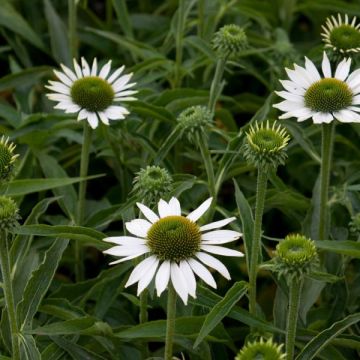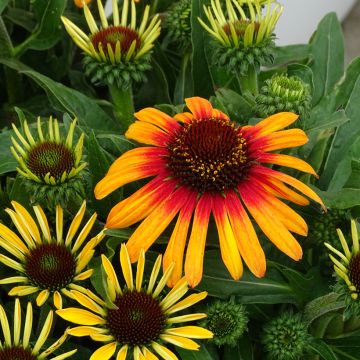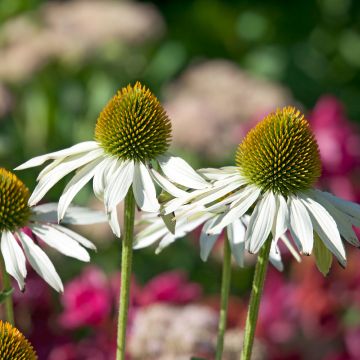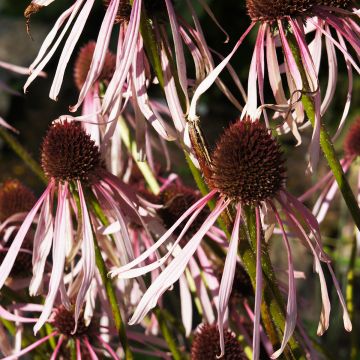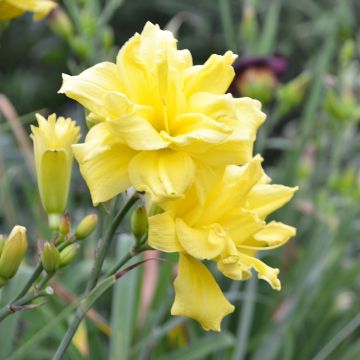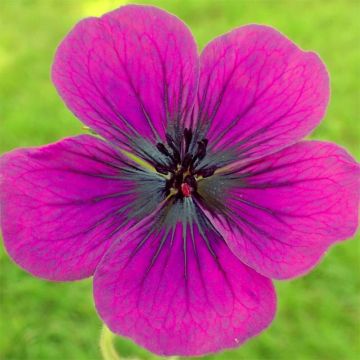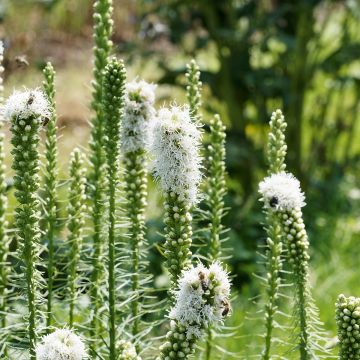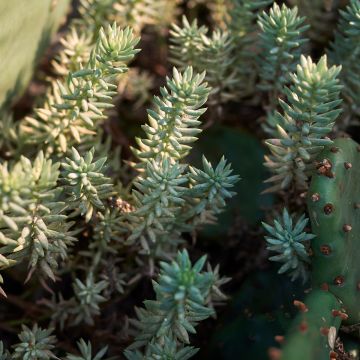

Echinacea purpurea Sun Magic Vintage Pink - Purple Coneflower
Echinacea purpurea Sun Magic Vintage Pink - Purple Coneflower
Echinacea purpurea Sun Magic Vintage Pink®
Eastern purple coneflower, Purple coneflower
We had to protect the young shoots from slugs, but it was worth it. These mini-sized coneflowers are all so cute.
Bérengère, 03/10/2024
This item cannot be shipped to the selected country
Delivery charge from €5.90
More information
Schedule delivery date,
and select date in basket
This plant carries a 12 months recovery warranty
More information
We guarantee the quality of our plants for a full growing cycle, and will replace at our expense any plant that fails to recover under normal climatic and planting conditions.
From €5.90 for pickup delivery and €6.90 for home delivery
Express home delivery from €8.90.
Does this plant fit my garden?
Set up your Plantfit profile →
Description
Echinacea Sun Magic® 'Vintage Pink' is a variety from the Sun Magic series, which offers compact, hardy cultivars with strong stems on well-branched plants. Their flowering is expressed in vibrant, long-lasting colours, with heads with fairly rigid ligules for horizontal, vibrant and cheerful flowers. 'Vintage Pink' offers large daisies in a fairly deep pink, with a prominent green-orange disk. Very floriferous, the plant produces 25 to 30 flowers per plant during the summer and into early autumn. It brightens up borders, sunny edges or flowering pots from the first year onwards.
Echinacea purpurea 'Vintage Pink' belongs to the Asteraceae family. It is a horticultural creation resulting from, among others, Echinacea purpurea, native to the western United States, from Georgia to Michigan, passing through Oklahoma and Ohio. 'Vintage Pink' has a bushy, upright and dense habit, reaching 60cm (24in) in height and 45cm (18in) in width. The lanceolate, green leaves are opposite and covered in rough hairs. The flowering is renewed from July to September, it is slightly fragrant and very popular with butterflies. The branched stems are topped with a solitary head, 10 to 12cm (4 to 5in) in diameter, with a disk surrounded by a collar of horizontal or slightly trailing ligules in pink. The fruit is an achene that releases seeds which are eagerly eaten by birds. This plant firmly and deeply anchors itself in the soil, thanks to its highly developed root system.
Echinacea 'Vintage Pink' is a resilient plant that adapts to difficult conditions, occasionally tolerating intense heat, humidity and drought. Its remarkably colourful flowering brings dynamism and good mood to borders. Pair it with flowers of similar colours but different shapes, such as daylilies, and bee balms. Its pink flowering is beautifully accompanied by the golden or pink spikes of ornamental grasses such as Stipa tenuifolia, Schizachyrium scoparium, or Muhlenbergia capillaris. Its vibrant combination with another foliage plant, Common Lady's Mantle, is superb. Finally, it brightens up fresh or dried flower bouquets.
Note: Please be aware that our plug plants are professional products intended for experienced gardeners: upon receipt, transplant them as soon as possible, in pots, containers or directly in borders.
Report an error about the product description
Flowering
Foliage
Plant habit
Botanical data
Echinacea
purpurea
Sun Magic Vintage Pink®
Asteraceae
Eastern purple coneflower, Purple coneflower
Cultivar or hybrid
Other Echinacea - Coneflower
Planting and care
Plant them in a fresh and deep soil, well worked, in a sunny location. These vigorous plants are greedy and will thrive better if you regularly provide them with a good fertilizer. Cut back faded flowers at the end of summer to avoid invasive self-seeding.
Echinaceas dread waterlogged soil in winter. The soil must be deep and loose to accommodate its root system. Deadhead the flowers as they fade. Divide the clump when flowering slows down. It is a rhizomatous plant that can become invasive if it likes its environment. Mulch the base in May to retain moisture during summer, as it is sensitive to lack of water during flowering.
Planting period
Intended location
Care
-
, onOrder confirmed
Reply from on Promesse de fleurs
Summer flowering perennials
Haven't found what you were looking for?
Hardiness is the lowest winter temperature a plant can endure without suffering serious damage or even dying. However, hardiness is affected by location (a sheltered area, such as a patio), protection (winter cover) and soil type (hardiness is improved by well-drained soil).

Photo Sharing Terms & Conditions
In order to encourage gardeners to interact and share their experiences, Promesse de fleurs offers various media enabling content to be uploaded onto its Site - in particular via the ‘Photo sharing’ module.
The User agrees to refrain from:
- Posting any content that is illegal, prejudicial, insulting, racist, inciteful to hatred, revisionist, contrary to public decency, that infringes on privacy or on the privacy rights of third parties, in particular the publicity rights of persons and goods, intellectual property rights, or the right to privacy.
- Submitting content on behalf of a third party;
- Impersonate the identity of a third party and/or publish any personal information about a third party;
In general, the User undertakes to refrain from any unethical behaviour.
All Content (in particular text, comments, files, images, photos, videos, creative works, etc.), which may be subject to property or intellectual property rights, image or other private rights, shall remain the property of the User, subject to the limited rights granted by the terms of the licence granted by Promesse de fleurs as stated below. Users are at liberty to publish or not to publish such Content on the Site, notably via the ‘Photo Sharing’ facility, and accept that this Content shall be made public and freely accessible, notably on the Internet.
Users further acknowledge, undertake to have ,and guarantee that they hold all necessary rights and permissions to publish such material on the Site, in particular with regard to the legislation in force pertaining to any privacy, property, intellectual property, image, or contractual rights, or rights of any other nature. By publishing such Content on the Site, Users acknowledge accepting full liability as publishers of the Content within the meaning of the law, and grant Promesse de fleurs, free of charge, an inclusive, worldwide licence for the said Content for the entire duration of its publication, including all reproduction, representation, up/downloading, displaying, performing, transmission, and storage rights.
Users also grant permission for their name to be linked to the Content and accept that this link may not always be made available.
By engaging in posting material, Users consent to their Content becoming automatically accessible on the Internet, in particular on other sites and/or blogs and/or web pages of the Promesse de fleurs site, including in particular social pages and the Promesse de fleurs catalogue.
Users may secure the removal of entrusted content free of charge by issuing a simple request via our contact form.
The flowering period indicated on our website applies to countries and regions located in USDA zone 8 (France, the United Kingdom, Ireland, the Netherlands, etc.)
It will vary according to where you live:
- In zones 9 to 10 (Italy, Spain, Greece, etc.), flowering will occur about 2 to 4 weeks earlier.
- In zones 6 to 7 (Germany, Poland, Slovenia, and lower mountainous regions), flowering will be delayed by 2 to 3 weeks.
- In zone 5 (Central Europe, Scandinavia), blooming will be delayed by 3 to 5 weeks.
In temperate climates, pruning of spring-flowering shrubs (forsythia, spireas, etc.) should be done just after flowering.
Pruning of summer-flowering shrubs (Indian Lilac, Perovskia, etc.) can be done in winter or spring.
In cold regions as well as with frost-sensitive plants, avoid pruning too early when severe frosts may still occur.
The planting period indicated on our website applies to countries and regions located in USDA zone 8 (France, United Kingdom, Ireland, Netherlands).
It will vary according to where you live:
- In Mediterranean zones (Marseille, Madrid, Milan, etc.), autumn and winter are the best planting periods.
- In continental zones (Strasbourg, Munich, Vienna, etc.), delay planting by 2 to 3 weeks in spring and bring it forward by 2 to 4 weeks in autumn.
- In mountainous regions (the Alps, Pyrenees, Carpathians, etc.), it is best to plant in late spring (May-June) or late summer (August-September).
The harvesting period indicated on our website applies to countries and regions in USDA zone 8 (France, England, Ireland, the Netherlands).
In colder areas (Scandinavia, Poland, Austria...) fruit and vegetable harvests are likely to be delayed by 3-4 weeks.
In warmer areas (Italy, Spain, Greece, etc.), harvesting will probably take place earlier, depending on weather conditions.
The sowing periods indicated on our website apply to countries and regions within USDA Zone 8 (France, UK, Ireland, Netherlands).
In colder areas (Scandinavia, Poland, Austria...), delay any outdoor sowing by 3-4 weeks, or sow under glass.
In warmer climes (Italy, Spain, Greece, etc.), bring outdoor sowing forward by a few weeks.


































